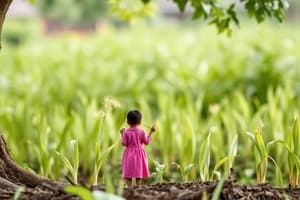Podcast
Questions and Answers
How many unique indicators are listed for the SDGs, considering repeated ones?
How many unique indicators are listed for the SDGs, considering repeated ones?
- 248 unique indicators
- 240 unique indicators
- 235 unique indicators
- 231 unique indicators (correct)
Which criterion is NOT one of the five criteria in selecting indicators for the SDGs?
Which criterion is NOT one of the five criteria in selecting indicators for the SDGs?
- Cost-effectiveness (correct)
- Statistical adequacy
- Timeliness
- Coverage
What is the purpose of establishing performance thresholds in measuring the SDGs?
What is the purpose of establishing performance thresholds in measuring the SDGs?
- To identify unnecessary indicators
- To determine the best and worst performers (correct)
- To compare past results directly
- To set indicators' valid measures
What does the International Spillover Index track?
What does the International Spillover Index track?
What must be true for the overall rating of a country to be considered red in the dashboard’s traffic light reading?
What must be true for the overall rating of a country to be considered red in the dashboard’s traffic light reading?
Which of the following issues presents a challenge in measuring the SDGs?
Which of the following issues presents a challenge in measuring the SDGs?
What is meant by 'censoring extreme values' in the context of creating indexes and scoring?
What is meant by 'censoring extreme values' in the context of creating indexes and scoring?
What is a significant problem caused by indicators that are still vague?
What is a significant problem caused by indicators that are still vague?
What is a significant impact of shocks on the poor compared to the non-poor?
What is a significant impact of shocks on the poor compared to the non-poor?
Which type of risk affects many people simultaneously?
Which type of risk affects many people simultaneously?
What does risk reduction primarily focus on?
What does risk reduction primarily focus on?
Which of the following is NOT considered a basic need for human development?
Which of the following is NOT considered a basic need for human development?
Which index combines measures of education, health, and purchasing power for socioeconomic development assessment?
Which index combines measures of education, health, and purchasing power for socioeconomic development assessment?
What does sustainability primarily concern itself with?
What does sustainability primarily concern itself with?
Which aspect is NOT mentioned as part of the aspects of sustainability?
Which aspect is NOT mentioned as part of the aspects of sustainability?
What is a characteristic of situational poverty?
What is a characteristic of situational poverty?
How many Quality of Life indicators does William Easterly describe?
How many Quality of Life indicators does William Easterly describe?
Which of the following strategies is NOT a method of coping with risk?
Which of the following strategies is NOT a method of coping with risk?
What is indicated by a decline in indicators such as life expectancy and infant mortality?
What is indicated by a decline in indicators such as life expectancy and infant mortality?
What are the three important categories for higher Quality of Life according to William Easterly?
What are the three important categories for higher Quality of Life according to William Easterly?
What is a typical source of risk that affects individuals or specific households?
What is a typical source of risk that affects individuals or specific households?
What does Amartya Sen's concept of capabilities focus on?
What does Amartya Sen's concept of capabilities focus on?
Which of the following freedoms is NOT included in Sen's Central Human Capabilities?
Which of the following freedoms is NOT included in Sen's Central Human Capabilities?
What type of poverty results from continuous movements between being poor and non-poor?
What type of poverty results from continuous movements between being poor and non-poor?
What is the outline of measuring the Sustainable Development Goals (SDGs)?
What is the outline of measuring the Sustainable Development Goals (SDGs)?
Which of the following is a challenge of sustainability in terms of social scope?
Which of the following is a challenge of sustainability in terms of social scope?
What does the concept of intergenerational equity in sustainability refer to?
What does the concept of intergenerational equity in sustainability refer to?
What major topic does not directly relate to the indicators for Quality of Life?
What major topic does not directly relate to the indicators for Quality of Life?
Flashcards are hidden until you start studying
Study Notes
Vulnerability to Shocks
- Exposure to shocks can lead to increased poverty incidence, particularly affecting the poor.
- Consequences can include lower future income, reduced food consumption, and prolonged periods of poverty.
- The poor exhibit higher risk aversion; income declines have a more significant impact on them compared to wealthier individuals.
Types of Risks
- Covariate risks affect large populations, while idiosyncratic risks impact individuals or specific households.
- Risks can lead to chronic poverty, persistent poverty from temporary shocks, or regular movement in and out of poverty.
Risk Reduction and Management
- Risk reduction involves strategies such as education, vaccination, and agricultural investments.
- Risk management focuses on mitigatory actions like savings, income diversification, and social capital investments.
- Coping mechanisms for shocks can include asset liquidation, child labor, or postponement of expenditures.
Basic Needs and Entitlements
- Basic needs encompass commodities or services crucial for human development, including health, education, and nutrition.
- Essential aspects include access to healthcare, educational enrollment and literacy rates, and nutrition levels measured by stunting and wasting rates.
Indicators of Basic Needs
- Human Development Index (HDI) combines measures of education, health, and GDP per capita to assess national development.
- Multidimensional Poverty Index (MPI) provides a broader perspective on poverty through various deprivations in education, health, and living standards.
Sustainability
- Sustainability emphasizes intergenerational equity, ensuring future generations benefit from natural resources usage.
- Key concerns include climate change, public debt, and the preservation of natural, human, physical, and social assets.
Quality of Life
- Quality of Life (QoL) includes individual rights, political stability, and the absence of negative factors such as crime and pollution.
- Development, as per Amartya Sen, expands individual freedoms and capabilities, allowing people to pursue productive activities and participate in society.
Measuring the Sustainable Development Goals (SDGs)
- SDGs comprise 169 targets and 231 unique indicators used for evaluating global development measures.
- These indicators are subject to criteria including relevance, statistical adequacy, timeliness, coverage, and measurable progress.
Challenges in Measuring SDGs
- Vague indicators, uneven data availability, and discrepancies in updated measures can complicate assessments.
- Index scores and rankings need careful interpretation due to potential recalibrations based on new data.
Creating Indexes and Scoring
- Performance thresholds are established for indicators; extreme values are censored for better clarity.
- Aggregation of indicators occurs across and within SDGs, requiring data normalization for comparability.
Using the Dashboard
- A traffic light system categorizes performance metrics; red indicates poor performance and green signifies satisfactory outcomes.
- Overall ratings depend on the two worst-performing metrics within each goal.
International Spillover Index
- This index measures how a nation's actions impact others’ environmental and social systems through trade and finance, emphasizing the interconnectedness of global development initiatives.
Studying That Suits You
Use AI to generate personalized quizzes and flashcards to suit your learning preferences.



